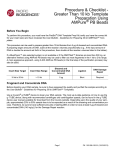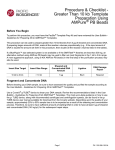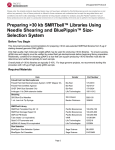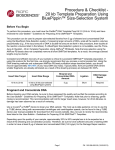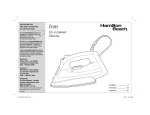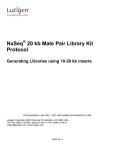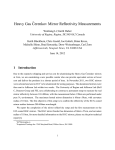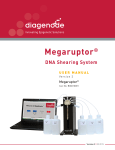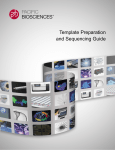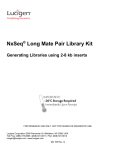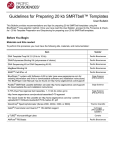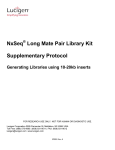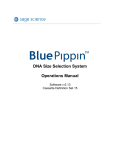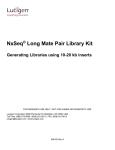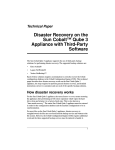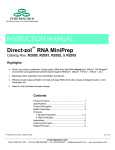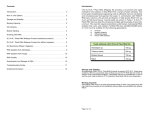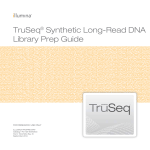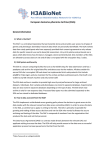Download Unsupported Protocol – Preparing > 30 kb SMRTbell™ Libraries
Transcript
Unsupported Protocol Please note: the shared protocols described herein may not have been validated by Pacific Biosciences and are provided as-is and without any warranty. Use of these protocols is offered to those customers who understand and accept the associated term s and ® conditions and wish to take advantage of their potential to help prepare samples for analysis using the PacBio System.If any of these protocols are to be used in a production environment, it is the responsibility of the end user to perform the required validation. Preparing > 30 kb SMRTbell™ Libraries Using the Megaruptor® Shearing and BluePippin™ Size-Selection System Before You Begin This document provides recommendations for preparing >30 kb size-selected SMRTbell libraries from 5 µg of starting sheared genomic DNA (gDNA). Only high-quality, high molecular weight gDNA may be used for producing >30 kb libraries. To ensure success, gDNA size and integrity must be verified by pulsed field gel electrophoresis before beginning library preparation. Additionally, conditions for shearing gDNA to a size that can support producing >30 kb libraries must also be determined and verified empirically for each sample. Overall yields of >30 kb libraries are typically 5-10%. For large genome projects, we recommend starting this procedure with >20 µg of high quality gDNA sample. Required Materials Item Pulsed Field Gel Electrophoresis Vendor Part Number Pulsed Field Gel Electrophoresis System: CHEF Mapper XA Bio-rad 170-3670 Pulsed Field Certified Agarose Bio-rad 162-0137 CHEF DNA Size Standard 5 kb Bio-rad 170-3624 Invitrogen 1 kb DNA extension ladder Life Technologies 10511-012 Megaruptor Diagenode B06010001 Long Hydropores Diagenode E07010002 Hydrotubes Diagenode C30010018 Pacific Biosciences 100-259-100 Shearing SMRTbell Library SMRTbell Template Prep Kit 1.0 SMRTbell Damage Repair Kit Pacific Biosciences 100-465-900 Ampure PB Beads Pacific Biosciences 100-265-900 Tube rotator (or equivalent) VWR 10136-084 Qubit 3.0 Fluorometer and Life Technologies Q33216 dsDNA HS Assay Kit or equivalent Life Technologies Q32854 BluePippin Size-Selection System Sage Science BLU0001 BluePippin Gel Cassettes Sage Science PAC30KB Size Selection Page 1 Unsupported Protocol Workflow QC gDNA by pulsed field gel electrophoresis ↓ Optimize shearing conditions (test shears) and QC by PFGE ↓ Large scale shears and QC by PFGE ExoVII treatment, DNA damage repair, End repair ↓ 0.45x Ampure PB bead purification ↓ Adapter ligation ↓ Exonuclease digestion ↓ 0.45x Ampure PB bead purification ↓ Size-selection ↓ 0.45x Ampure PB bead purification ↓ DNA damage repair ↓ 0.45x Ampure PB bead purification QC ↓ Prepare for sequencing Figure 1: Workflow for preparing >30 kb SMRTbell libraries. Page 2 Unsupported Protocol Evaluate Genomic DNA Quality We highly recommend using BIO-RAD® CHEF Mapper® XA Pulsed Field Electrophoresis for resolution above 50 kb. Other systems do not provide good resolution above 50 kb. Genomic DNA suitable for preparing >30-kb libraries will migrate almost exclusively above ~50 kb (for example, see Figure 2, Sample 1). If significant portion of the gDNA migrates below ~50 kb (for example, see Figure 2, Sample 2), do not proceed with the 30 kb size selection protocol. Instead, refer to “Shared Protocol - 20 kb Template Preparation Using BluePippin™ Size-Selection System (15 kb Size Cutoff)” for recommendations on how to prepare >6-kb to >15-kb libraries. Figure 2: Evaluation of gDNA quality by pulsed-field gel electrophoresis. Lane 1 contains the 1 kb extension DNA ladder, and Lane 4 the Bio-Rad 5 kb DNA ladder. Sample 1 provides an example of high quality, high molecular weight gDNA. The gDNA of Sample 2 should not be used for the production of a >30-kb library. Optimize Shearing Conditions and Shear gDNA To ensure sufficient yields of final >30 kb libraries, input gDNA must be sheared carefully so that the average size of fragmented DNA remains well above the desired size-selection cut-off. The response of individual gDNA samples to recommended shearing parameters may differ and must be determined empirically and evaluated by pulsed field gel electrophoresis. Test shears are highly recommended. Note that for preparing >30 kb libraries, gDNA may be sheared by using Dagenode’s Megaruptor. Here we provide initial starting parameters methods as well as strategies for optimization of gDNA shearing, if necessary. Page 3 Unsupported Protocol Shearing Using Diagenode’s Megaruptor For shearing gDNA using Diagenode’s Megaruptor, generally follow the manufacturer’s recommendations. 1. Dilute your gDNA in EB to 50 ng/µL in a volume of 50 µL to 400 µL. It is important not to exceed this DNA concentration during Megaruptor shearing or you may clog the hydropore. Before shearing, remove a 4 µL aliquot for QC (un-sheared sample). 2. To shear gDNA for preparation of a >30 kb library, choose a target shear size of 50 kb in the Megaruptor software; for a >40 kb library, choose a target shear size of 75 kb. For both of these target shear sizes you must use Long Hydropores, and have the Long Hydropore option selected in the Megaruptor software. 3. Evaluate the distribution of the resulting sheared gDNA by running the un-sheared and sheared samples on a BIO-RAD® CHEF Mapper® XA Pulsed Field Electrophoresis. Other systems do not provide good resolution above 50 kb. Typical results are shown in Figure 3 for a bacterial gDNA sample. The MR_50kb shear shown here was used to prepare a >30 kb library, and the MR_75kb shear was used to prepare a >40 kb library. If the gDNA sample appears under-sheared, try smaller target shear sizes (for example, 40 kb for a >30 kb library) and/or a lower DNA concentration until you achieve a similar distribution of fragmented gDNA. If the gDNA sample is over-sheared, try a larger target shear size (for example, 75 kb for a >30 kb library). It is also possible to increase or decrease the number of shearing cycles; contact Diagenode customer support to enable this option. PacBio has not has not developed a tested protocol for this option. Figure 3: Evaluation of gDNA shears produced by Megaruptor (MR). The first lane contains the 1 kb extension DNA ladder, and the last the Bio-Rad 5 kb DNA ladder. MR_50kb and MR_75kb are good shears for a 30 kb size selection. Sample g-TUBE is oversheared and not appropriate for 30 kb size selection. Input K12 gDNA=E.coli genomic DNA; g-TUBE=genomic DNA sheared with g-TUBE; MR_50kb=50kb shear size in the Megaruptor software; MR_75kb=75kb shear size in the Megaruptor software. Page 4 Unsupported Protocol Concentrate DNA Using AMPure PB Beads (if necessary) If the concentration of sheared gDNA is less than 140 ng/µL, concentrate the sheared gDNA using AMPure PB Bead purification before proceeding. If the sheared gDNA concentration is greater than 140 ng/uL, adjust gDNA concentration to 140 ng/uL with EB and proceed directly to ExoVII treatment below. ST EP 1 Concentrate DNA Add 0.45X volume of AMPure® PB magnetic beads. μL of sample X 0.45X = μL of beads Note that the beads must be brought to room temperature and all AMPure PB bead purification steps should be performed at room temperature. Before using, mix the bead reagent well until the solution appears hom ogenous. Pipette the reagent slowly since the bead mixture is viscous and precise volumes are critical to the purification process. 2 Mix bead/DNA solution thoroughly by tapping the tube gently. Do not pipet to mix. 3 Quickly spin down the tube (for 1 second) to collect the beads. 4 Allow the DNA to bind to beads by gentle end-over-end rotation for 20 minutes at room temperature. We recommend using a VW R tube rotator. 5 Spin down the tube (for 1 second) to collect beads. 6 Place the tube in a magnetic bead rack until the beads collect to the side of the tube and the solution appears clear. The actual time required to collect the beads to the side depends on the volume of beads added. 7 With the tube still on the magnetic bead rack, slowly pipette off cleared supernatant and save in another tube. Avoid disturbing the bead pellet. If the DNA is not recovered at the end of this Procedure, you can add equal volumes of AMPure PB beads to the saved supernatant and repeat the AMPure PB bead purification steps to recover the DNA. 8 W ash beads with freshly prepared 70% ethanol. Note that 70% ethanol is hygroscopic and should be prepared FRESH to achieve optim al results. Also, 70% ethanol should be stored in a tightly capped polypropylene tube for no m ore than 3 days. – Do not remove the tube from the m agnetic rack. – Use a sufficient volume of 70% ethanol to fill the tube (1.5 mL for 1.5 m L tube or 2 m L for 2 m L tube). Slowly dispense the 70% ethanol against the side of the tube opposite the beads. Let the tube sit for 30 seconds. – Do not disturb the bead pellet. – After 30 seconds, pipette and discard the 70% ethanol. 9 Repeat step 8. 10 Rem ove residual 70% ethanol. 11 – Rem ove tube from m agnetic bead rack and spin to pellet beads. Both the beads and any residual 70% ethanol will be at the bottom of the tube. – Place the tube back on m agnetic bead rack. – Pipette off any rem aining 70% ethanol. Check for any remaining droplets in the tube. If droplets are present, repeat step 10. Page 5 Notes Unsupported Protocol ST EP Concentrate DNA 12 Rem ove the tube from the m agnetic bead rack and allow beads to air-dry (with the tube caps open) for 60 seconds. 13 Calculate appropriate volum e of Elution Buffer. ng X 0.5 / ( ng/μL) = μL of Elution Buffer needed The m inimum DNA concentration required to proceed to the next step (End-Repair) is 140 ng/μL with preferred m ass of at least 5 μg. 14 Add the Pacific Biosciences® Elution Buffer volum e (calculated in step 13) to your beads. Tap the tube with finger gently to mix. Do not pipet to mix. – Elute the DNA by gentle letting the mix stand at room temperature for 2 minutes – Spin the tube down to pellet beads, then place the tube back on the m agnetic bead rack. – Perform concentration m easurem ents. Verify your DNA concentration using a Nanodrop® or Qubit® quantitation platform . If the DNA concentration is estim ated to be equal to or below 12 ng/μL, a Qubit system reading is required. W hen perform ing a Qubit system reading, ensure that your sam ple is within the range of the Qubit kit you are using. For proper concentration calculations, incorporate the dilution factor (used when diluting your sam ple) to be within range of the Qubit kit and the dilution factor when diluting your sam ple with the working solution. The latter part of this dilution factor can be calculated autom atically by the Qubit system. – Discard the beads. 15 Perform concentration measurements. – Measure the DNA concentration using a Qubit fluorometer. – Using 1 μL of the eluted sample, make a 1:10 dilution in EB. – Use 1 µL of this 1:10 dilution to measure the DNA concentration using a Qubit fluorometer and the dsDNA HS Assay kit according to the manufacturer’s recommendations. Yield up to this point should be 40-60%. The remaining 9 μL of 1:10 diluted sample may be used for QC by pulsed field gel electrophoresis (see example in Figure 4). 16 The sheared DNA can be stored for up to 24 hours at 4°C or at -20°C for longer duration. 17 Actual recovery per μL and total available sample material: Page 6 Notes Unsupported Protocol ExoVII Pre-treatment of DNA Use the following table to set up a reaction to remove single-stranded ends from 5 µg of sheared gDNA at 140 ng/µL. If starting with more than 5 µg of sheared gDNA, scale reaction volumes proportionally (i.e., for 10 μg of DNA scale the total volume to 96 μL). Reagent Sheared DNA (5 µg) Tube Cap Color Stock Conc. − Volume Final Conc. 36.0 μL − DNA Dam age Repair Buffer 10 X 5.0 μL 1X NAD+ 100 X 0.5 μL 1X ATP high 10 mM 5.0 μL 1 mM dNTP 10 mM 0.5 μL 0.1 mM ExoVII 10 U/μL 1.0 μL 0.2 U/μL 48.0 μL − Total Volume 2. Mix the reaction well by gently tapping the tube. 3. Spin down contents of tube with a quick spin in a microfuge. 4. Incubate at 37°C for 15 minutes, then return the reaction to 4°C. Page 7 Notes Unsupported Protocol Repair DNA Damage Use the following table to prepare your reaction. For more than 5 µg input DNA, scale all reaction volumes proportionally. Reagent DNA (ExoVII treated) Tube Cap Color Stock Conc. − DNA Damage Repair Mix 25 X Total Volume Volume Final Conc. 48 μL − 2.0 μL 1X 50.0 μL − Notes 1. Mix the reaction well by gently tapping the tube. 2. Spin down contents of tube with a quick spin in a m icrofuge. 3. Incubate at 37°C for 60 minutes, return the reaction to 4°C for 1 to 5 minutes. Repair Ends Use the following table to prepare your reaction. For more than 5 µg input DNA, scale all reaction volumes proportionally. Reagent DNA (Dam age Repaired) End Repair Mix Tube Cap Color Stock Conc. − 20 X Total Volum e Volume Final Conc. 52.0 μL − 2.5 μL 1X 52.5 μL − 1. Mix the reaction well by gently tapping the tube. 2. Spin down contents of tube with a quick spin in a microfuge. 3. Incubate at 25°C for 5-10 minutes, return the reaction to 4°C. Page 8 Notes Unsupported Protocol Purify DNA Using 0.45X AMPure PB Beads ST EP Purify DNA 1 Add 0.45X volum e of AMPure PB beads to the End-Repair reaction. 2 Mix the bead/DNA solution thoroughly by gently tapping the tube. 3 Quickly spin down the tube (for 1 second) to collect the beads. Do not pellet beads. 4 Allow the DNA to bind to beads by gentle rotation for 20 minutes at room temperature. W e recomm end using a VW R tube rotator. 5 Spin down the tube (for 1 second) to collect beads. 6 Place the tube in a m agnetic bead rack to collect the beads to the side of the tube. 7 Slowly pipette off cleared supernatant and save (in another tube). Avoid disturbing the bead pellet. 8 W ash beads with freshly prepared 70% ethanol. 9 Repeat step 8. 10 Rem ove residual 70% ethanol. – Rem ove tube from m agnetic bead rack and spin to pellet beads. Both the beads and any residual 70% ethanol will be at the bottom of the tube. – Place the tube back on m agnetic bead rack. – Pipette off any rem aining 70% ethanol. 11 Check for any rem aining droplets in the tube. If droplets are present, repeat step 10. 12 Rem ove the tube from the m agnetic bead rack and allow beads to air-dry (with tube caps open) for 60 seconds. 13 For 5 µg input sheared gDNA, elute in 23 µL Elution buffer. If you started with more than 5 µg input sheared gDNA, scale volume of EB proportionally (i.e., for 10 μg of DNA, elute in 46 μL EB). Mix by gently tapping the tube. Elute by letting it sit at room temperature for 2 minutes. 14 Optional: Verify your DNA amount and concentration using a Qubit quantitation platform. 15 The End-Repaired DNA can be stored overnight at 4°C or at -20°C for longer durations. 16 Actual recovery per μL and total available sample material: End-Repaired insert DNA can be stored overnight at 4°C or at -20°C for longer durations. Page 9 Notes Unsupported Protocol Prepare Blunt-Ligation Reaction Use the following table to prepare your reaction, adding the components below in the order listed. Be sure to mix insert gDNA and adapter BEFORE adding ligase. For more than 5 µg input DNA, scale all reaction volumes proportionally. Reagent Tube Cap Color Stock Volume Final Conc. Notes Conc. DNA (End Repaired) − 23.0 μL 20 μM Annealed Blunt Adapter (20 μM) 10 μL 5 μM Finger tap to mix before proceeding Tem plate Prep Buffer 10 X 4.0 μL 1X ATP low 1 mM 2.0 μL 0.05 mM Finger tap to mix before proceeding Ligase Total Volum e 1. 2. 3. 4. − 30 U/μL 1.0 μL 0.75 U/μL − 40.0 μL − Mix the reaction well by gently tapping the tube. Spin down contents of tube with a quick spin in a microfuge. Incubate at 25°C or room temperature overnight. Incubate at 65°C for 10 minutes to inactivate the ligase, then return the reaction to 4°C. ExoIII/VII Digestion to Remove Failed Ligation Products Use the following table to prepare your reaction. For more than 5 µg input DNA,scale all reaction volumes proportionally. Reagent Tube Cap Color Stock Conc. Volume 40 μL Ligated DNA ExoIII 100.0 U/μL 1.0 μL ExoVII 10.0 U/μL 1.0 μL 42 μL Tot al Volume 1. Mix the reaction well by gently tapping the tube. 2. Spin down contents of tube with a quick spin in a microfuge 3. Incubate at 37°C for 1 hour, then return the reaction to 4°C. You must immediately proceed with AMPure PB bead purification after this step. Page 10 Unsupported Protocol Purify SMRTbell™ Templates with 0.45X AMPure PB Beads ST EP Purify DNA 1 Add 0.45X volum e of AMPure PB beads to the End-Repair reaction. 2 Mix the bead/DNA solution thoroughly by gently tapping the tube. 3 Quickly spin down the tube (for 1 second) to collect the beads. Do not pellet beads. 4 Allow the DNA to bind to beads by gentle rotation for 20 minutes at room temperature. W e recomm end using a VW R tube rotator. 5 Spin down the tube (for 1 second) to collect beads. 6 Place the tube in a m agnetic bead rack to collect the beads to the side of the tube. 7 Slowly pipette off cleared supernatant and save (in another tube). Avoid disturbing the bead pellet. 8 W ash beads with freshly prepared 70% ethanol. 9 Repeat step 8. 10 Notes Rem ove residual 70% ethanol. – Rem ove tube from m agnetic bead rack and spin to pellet beads. Both the beads and any residual 70% ethanol will be at the bottom of the tube. – Place the tube back on m agnetic bead rack. – Pipette off any rem aining 70% ethanol. 11 Check for any remaining droplets in the tube. If droplets are present, repeat step 10. 12 Rem ove the tube from the m agnetic bead rack and allow beads to air-dry (with tube caps open) for 60 seconds. 13 For up to 10 µg input sheared gDNA, elute in 31 µL Elution buffer. If you started with more than 5 µg input sheared gDNA, scale volume of EB proportionally (i.e., for 20 μg of DNA, elute in 62 μL EB). Mix by gently tapping the tube. Elute by letting it sit at room temperature for 2 minutes., 14 Verify your DNA amount and concentration using a Qubit quantitation platform. – Measure the DNA concentration using a Qubit fluorometer. – Using 1 μL of the eluted sample, make a 1:10 dilution in EB. – Use 1 µL of this 1:10 dilution to measure the DNA concentration using a Qubit fluorometer and the dsDNA HS Assay kit according to the manufacturer’s recommendations. Yield up to this point should be 40-60%. The remaining 9 μL of 1:10 diluted sample may be used for QC by pulsed field gel electrophoresis (see example in Figure 4). 15 Optional: Perform qualitative and quantitative analysis using a Bioanalyzer instrum ent with the DNA 12000 Kit. Note that typical yield at this point of the process (following End-Repair and one 0.45X AMPure PB bead purification) is approxim ately between 80-100% of the total starting m aterial. 16 Actual recovery per μL and total available sam ple m aterial: Proceed immediately with size-selection after AMPure PB Bead purification of exonuclease-treated libraries. Samples may be stored at -20°C for short periods at this stage, if necessary. Page 11 Unsupported Protocol Size-Selection Using the BluePippin™ System Follow the instructions in the BluePippin User Manual and User Guides (see www.sagescience.com), and the specific recommendations below, for >30 kb or 40 kb size-selection of the SMRTbell tem plates. Note that you must use BluePippin Software v6.20 and the “0.75%, DF Marker U1 high-pass 30 kb – 40 kb v3” run protocol for this procedure. A new size standard is required for this protocol. Use the U1 marker. 1. Prepare up to 5 μg SMRTbell templates in a final volume of 30 μL Elution Buffer for each lane. Size selection using this protocol can be aggressive and if not careful, recovery may be impacted. It is not recommended to use less than 4 μg per lane. 2. Bring the Loading Solution to room temperature, then add 10 μL of the Loading Solution to the 30 μL DNA sample. For multiple lanes, scale volumes proportionally. The Loading Solution is viscous so pipet slowly to ensure complete transfer into the DNA sample. a. Mix by tapping the tube gently; do not vortex. b. Spin briefly to collect the contents at the bottom of the tube. 3. Follow the manufacturer’s recommendations to set up a run protocol. a. When setting up the run protocol, select the “0.75% DF marker S1 high-pass 30-40kb v3” cassette definition file. b. Using the “Range” selection mode, enter the desired “BPstart” value of 30000 or 40000 bp. A “BP End” value of 80000 bp should automatically appear. Be sure to assign a marker lane. 4. Load samples and start the run. Be sure to include the U1 marker in the correct lane. Typical run times are ~10 hours. 5. To maximize recovery of eluted DNA, wait at least 45 minutes after the run terminates before removing the sample from the elution chamber. a. Collect the eluate into a 1.5 mL DNA LoBind tube. b. Wash elution well with 40 µL of Sage Science’s 0.1% Tween-20 Wash Solution, and add wash to eluted sample. Washing the elution well may increase yield 10-20%. Page 12 Unsupported Protocol Purify Size-Selected SMRTbell™ Templates with 0.45X AMPure PB Beads ST EP Purify DNA 1 Add 0.45X volume of AMPure PB beads to the End-Repair reaction. 2 Mix the bead/DNA solution thoroughly by gently tapping the tube. 3 Quickly spin down the tube (for 1 second) to collect the beads. Do not pellet beads. 4 Allow the DNA to bind to beads by gentle rotation for 20 minutes at room temperature. W e recomm end using a VW R tube rotator. 5 Spin down the tube (for 1 second) to collect beads. 6 Place the tube in a m agnetic bead rack to collect the beads to the side of the tube. 7 Slowly pipette off cleared supernatant and save (in another tube). Avoid disturbing the bead pellet. 8 W ash beads with freshly prepared 70% ethanol. 9 Repeat step 8. 10 Notes Remove residual 70% ethanol. – Remove tube from magnetic bead rack and spin to pellet beads. Both the beads and any residual 70% ethanol will be at the bottom of the tube. – Place the tube back on magnetic bead rack. – Pipette off any remaining 70% ethanol. 11 Check for any remaining droplets in the tube. If droplets are present, repeat step 10. 12 Remove the tube from the magnetic bead rack and allow beads to air-dry (with tube caps open) for 60 seconds. 13 For up to 5 µg input non-size-selected library gDNA, elute in 23 µL Elution buffer. If you size-selected more than 5 µg of SMRTbell template, scale volume of EB proportionally (i.e., for up to 10 μg of input DNA, elute in 20 μL EB). Mix by gently tapping the tube, elute by letting the tube sit for two minutes at room temperature. 14 Verify your DNA amount and concentration using a Qubit quantitation platform. – Using 1 μL of the purified sample, make a 1:10 dilution in EB. – Use 1 µL of this 1:10 dilution to measure the DNA concentration using a Qubit fluorometer and the dsDNA HS Assay kit according to the manufacturer’s recommendations. Size-selection set yield should be 20-40%. The remaining 9 μL of 1:10 diluted sample may be used for QC by pulsed field gel electrophoresis. 15 Actual recovery per μL and total available sam ple m aterial: AMPure PB bead purified, size-selected libraries may be stored at -20°C. Page 13 Unsupported Protocol Repair DNA Damage After Size-Selection Using the table below, set up a reaction to repair any DNA damage present in SMRTbell templates after >30 kb or >40 kb size-selection. For up to 5 µg of DNA, use a reaction volume of 50 µL. If starting with more than 5 µg of size-selected template, scale reaction volumes proportionally (i.e., for up to 10 μg of DNA use a 100 μL reaction volume). Reagent Size-selected DNA Tube Cap Color Stock Conc. Volume − μL for 5.0 μg Final Conc. − DNA Dam age Repair Buffer 10 X 5.0 μL 1X NAD+ 100 X 0.5 μL 1X ATP high 10 mM 5.0 μL 1 mM dNTP 10 mM 0.5 μL 0.1 mM H2O 2.0 μL 25 X DNA Dam age Repair Mix − μL to adjust to 50.0 μL 50.0 μL Total Volume 2. Mix the reaction well by gently tapping the tube. 3. Spin down contents of tube with a quick spin in a microfuge. 4. Incubate at 37°C for 60 minutes. Page 14 1X − − Notes Unsupported Protocol Purify Damage-Repaired, Size-Selected SMRTbell™ Templates with 0.45X AMPure PB Beads ST EP Purify DNA 1 Add 0.45X volume of AMPure PB beads to the End-Repair reaction. 2 Mix the bead/DNA solution thoroughly by gently tapping the tube. 3 Quickly spin down the tube (for 1 second) to collect the beads. Do not pellet beads. 4 Allow the DNA to bind to beads by gentle rotation for 20 minutes at room temperature. W e recomm end using a VW R tube rotator. 5 Spin down the tube (for 1 second) to collect beads. 6 Place the tube in a m agnetic bead rack to collect the beads to the side of the tube. 7 Slowly pipette off cleared supernatant and save (in another tube). Avoid disturbing the bead pellet. 8 W ash beads with freshly prepared 70% ethanol. 9 Repeat step 8. 10 Notes Remove residual 70% ethanol. – Rem ove tube from magnetic bead rack and spin to pellet beads. Both the beads and any residual 70% ethanol will be at the bottom of the tube. – Place the tube back on magnetic bead rack. – Pipette off any rem aining 70% ethanol. 11 Check for any remaining droplets in the tube. If droplets are present, repeat step 10. 12 Rem ove the tube from the m agnetic bead rack and allow beads to air-dry (with tube caps open) for 60 seconds. 13 For up to 5 µg size-selected library, elute in 10 µL Elution buffer. For more than 5 µg of SMRTbell template, scale volume of EB proportionally (i.e., for up to 10 μg of input DNA, elute in 20 μL EB). Mix by gently tapping the tube, elute by lettting it sit for two minutes at room temperature. 14 Verify your DNA amount and concentration using a Qubit quantitation platform. – Using 1 μL of the purified sample, make a 1:10 dilution in EB. – Use 1 µL of this 1:10 dilution to measure the DNA concentration using a Qubit fluorometer and the dsDNA HS Assay kit according to the manufacturer’s recommendations. The remaining 9 μL of 1:10 diluted sample may be used for QC by pulsed field gel electrophoresis (see example in Figure 4). Page 15 Unsupported Protocol Figure 4: Evaluation of >30 kb and >40 kb libraries using pulsed-field gel electrophoresis. The first lane contains the 1 kb extension DNA ladder, and the last the Bio-Rad 5 kb DNA ladder. Samples are as indicated above each lane. Anneal and Bind BluePippin™ Size-Selected SMRTbell™ Templates Using the Binding Calculator, compute the molarity of your library by using an average insert size of 30000 bp for >30 kb libraries, and 40000 bp for >40 kb libraries. Anneal 2 0 X sequencing primer at a template concentration of 0.833 nM, as directed by the Binding Calculator. Before adding the primer to the SMRTbell template, pre-condition the primer by heating to 80ºC for 2 minutes, then placing immediately on ice. (Note that if kept on ice during use, and stored at -20ºC, preconditioned primer may be used multiple times without re-heating.) Add the appropriate amounts of preconditioned primer and 10X Primer Buffer to the SMRTbell template, and incubate at 20ºC for at least 30 minutes. Bind 10X P6 polymerase at an annealed template concentration of 0.500 nM, according to the Binding Calculator. For >30 and >40 kb libraries, incubation of the binding reaction at 30ºC for 4 hours may modestly improve loading relative to 30 minute binding reactions. Prepare for MagBead Loading Optimal loading of >30 and >40 kb SMRTbell libraries using P6 polymerase can typically be achieved using an on-plate concentration of ~0.225nM to 0.375 nM. We recommend you perform an initial loading titration in this range to determine optimal loading for your sample, for example 0.225 nM, 0.300 nM and 0.375 nM. For efficient binding to Magnetic Beads, bound complexes (at 0.500 nM concentration) must be diluted in the appropriate ratio of MagBead Binding Buffer and MagBead Wash Buffer. Follow the Binding Calculator instructions to dilute your sample for MagBead binding. Page 16 Unsupported Protocol SMRT Cells for Large-Scale Sequencing Projects A loading titration should be performed with each new SMRT Cell lot to determine the optimal on-plate sample concentrations. If possible, large multi-SMRT Cell genome projects should be completed with a minimum number of lots to decrease the number of loading titrations. When placing an order of SMRT Cells, indicate on the Purchase Order to “MINIMIZE SMRT Cell lots” (please use this exact phrase). Control Complex Dilution If you will be using the PacBio® Control Complex, dilute the DNA Control Complex according to the volumes and instructions specified in the Calculator. Sequence Note that you must have a DNA Sequencing Kit and SMRT® Cells for standard sequencing. When sequencing >30 and >40 kb SMRTbell libraries, be sure to choose the correct magnetic bead collection protocol (v2 or OCPW), i n d i c a t e a 20,000 bp insert size, a n d s e l e c t stage start when setting up your run protocol. We recommend 240 or 360 minute movies for >30 and >40 kb libraries. For Research Use Only. Not for use in diagnostic procedures. © Copyright 2015, Pacific Biosciences of California, Inc. All rights reserved. Information in this document is subject to change without notice. Pacific Biosciences assumes no responsibility for any errors or omissions in this document. Certain notices, terms, conditions and/o r use restrictions may pertain to your use of Pacific Biosciences products and/or third p arty products. Please refer to the applicable Pacific Biosciences Terms and Conditions of S ale and to the applicable license terms at http://www.pacificbiosciences.com/lice nses.html. Pacific Biosciences, the Pacific Biosciences logo, PacBio, S MRT, SMRTbell and Iso-Seq are trademarks of Pacific Biosciences. BluePippin and SageELF are trademarks of Sage Science, Inc. NGS-go and NGSengine are trademarks of GenDx. All other trademarks are the sole property of their respective owners Page 17

















